AT some time or the other, the whole world is said to come to Aurangabad to inspect the fabulous heritage of its Buddhist, Hindu and Jain caves at Ajanta and Ellora. Or to take in the beauty of its Paithani sarees and Himroo shawls. But few of these people ever take time out to look through the Aurangabad city itself. And that is such a pity. For Aurangabad has much to offer everyone, from the history-seeker and adventurer to the student of architecture and sleuthing foodie in search of new and exciting places to have a meal of the local fare. Most of the places of tourist interest an entry fee and fixed timings. And photography is not allowed at several of them. So make inquiries before setting out.
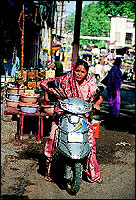 Aurangabad is Maharashtra�s most important tourist destination, it is fringed by the Satmala Hills and the Kaum River, and is not too far from Bombay by road � just 390 kilometres or an eight-hour drive. The train takes lesser time than that. But air is the quickest: the flight from Bombay is just 45 minutes.
Aurangabad is Maharashtra�s most important tourist destination, it is fringed by the Satmala Hills and the Kaum River, and is not too far from Bombay by road � just 390 kilometres or an eight-hour drive. The train takes lesser time than that. But air is the quickest: the flight from Bombay is just 45 minutes.
The city can be quickly explored in a day, you could drive around in a couple of hours, but if you want to really to experience Aurangabad, you will require two or three days. The best time to go there is the winter, as summers in Aurangabad can be scorching, but the city is also pleasant after the monsoon in September.
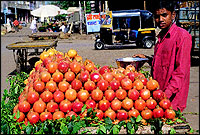 Aurangabad, of course, gets its name from the man who brought the mighty Mughal dynasty of Zahiruddin Babbar to an end over here. Mohammed Aurangzeb, Babar�s sixth descendant, lies buried in Khuldabad just 24 kilometres outside Aurangabad. He was the most able commander and son of his father, Emperor Shah Jehan, but he was also the most wronged son according to travelogues on the city.
Aurangabad, of course, gets its name from the man who brought the mighty Mughal dynasty of Zahiruddin Babbar to an end over here. Mohammed Aurangzeb, Babar�s sixth descendant, lies buried in Khuldabad just 24 kilometres outside Aurangabad. He was the most able commander and son of his father, Emperor Shah Jehan, but he was also the most wronged son according to travelogues on the city.
Aurangzeb was kept away from the seat of empire in Delhi and left to battle the feisty Marathas in the heat of the Deccan Plateau. He fought the Maratha warrior king Chhatrapati Shivaji�s son Sambhaji and died defending his territory on the ghats from the Maratha warriors. Perhaps, knowing that there would be no peace for him as long as he lived, Aurangzeb chose Rauza (the Abode of Peace) in Khuldabad as his final resting place.
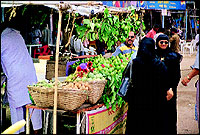 His tomb there today which lies in verdant and quiet surroundings, is a place of tourist interest. And curiously enough, one of the big sweetmeat delicacies of Aurangabad, the Khaja, is sold in little tents right outside the tomb. Nobody who visits the place comes away without sampling the sweet.
His tomb there today which lies in verdant and quiet surroundings, is a place of tourist interest. And curiously enough, one of the big sweetmeat delicacies of Aurangabad, the Khaja, is sold in little tents right outside the tomb. Nobody who visits the place comes away without sampling the sweet.
Aurangzeb is just a strong memory in Aurangabad, but the Muslims live on, and now in harmony with the Marathas, all over the city. Everywhere you go, you will come across beautiful young women hidden by the mysteries of the purdah zipping about Aurangabad on scooters and even motorcycles, shyly buying vegetables in marketplaces, and visiting the city�s monuments with young and
new husbands.
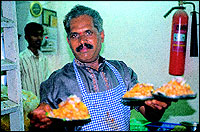 Aurangabad has a sizeable population of members belonging to the Dawoodi Bohra community as well and these people are traders, they deal in perfumes, Unani medicines, hardware, and have other establishments. Another area of great Muslim influence in Aurangabad is education. The city is a wonderful and renowned seat of learning thanks to the Maulana Azad Educational Trust started by Dr. Rafiq Zakaria and its colleges of arts, science, commerce, its polytechnic, technological institute, colleges of pharmacy, journalism, computers, information technology, management and hotel management. Students come from far and wide to seek admissions in these institutes and they come bringing their own cultures with them, adding to the melange that already exists in Aurangabad.
Aurangabad has a sizeable population of members belonging to the Dawoodi Bohra community as well and these people are traders, they deal in perfumes, Unani medicines, hardware, and have other establishments. Another area of great Muslim influence in Aurangabad is education. The city is a wonderful and renowned seat of learning thanks to the Maulana Azad Educational Trust started by Dr. Rafiq Zakaria and its colleges of arts, science, commerce, its polytechnic, technological institute, colleges of pharmacy, journalism, computers, information technology, management and hotel management. Students come from far and wide to seek admissions in these institutes and they come bringing their own cultures with them, adding to the melange that already exists in Aurangabad.
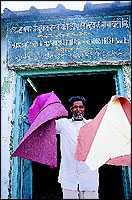 The roads that go out of Aurangabad are the ones that archaeologists and students of history take. They lead to some of India�s most important sites of heritage and natural wealth. The western road to Bombay goes past Ellora�s Buddhist caves; the southern road to Paithan, on the banks of the Godavari; the northern road to Jalgaon and along which are a number of sights leading upto Ajanta; and, the Jalna road is on the east.
The roads that go out of Aurangabad are the ones that archaeologists and students of history take. They lead to some of India�s most important sites of heritage and natural wealth. The western road to Bombay goes past Ellora�s Buddhist caves; the southern road to Paithan, on the banks of the Godavari; the northern road to Jalgaon and along which are a number of sights leading upto Ajanta; and, the Jalna road is on the east.
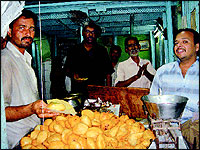 But within the city itself, are the Bibi-ka-Maqbara, a tribute not unlike the Taj Mahal in Agra but this one to Aurangzeb�s wife Begum Rabia Durani by her son Azam Shah. And there is the Panchakki, a water wheel that works in the day and age and which draws water from a reservoir six kilometres away through an elaborate assemblage of ceramic pipes and and an iron fan that also churns electricity for a flour mill to grind grain for pilgrims.
But within the city itself, are the Bibi-ka-Maqbara, a tribute not unlike the Taj Mahal in Agra but this one to Aurangzeb�s wife Begum Rabia Durani by her son Azam Shah. And there is the Panchakki, a water wheel that works in the day and age and which draws water from a reservoir six kilometres away through an elaborate assemblage of ceramic pipes and and an iron fan that also churns electricity for a flour mill to grind grain for pilgrims.
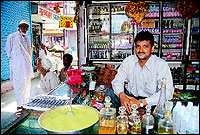 The city still has some of its old darwazas like the Delhi, Paithan, Jalna and Mecca darwazas that have withstood the elements like they did the attacks of the Marathas, but these are withering with age and almost reduced to rubble in some places. Then there are a number of masjids and dargahs scattered around the city, with the Jama Masjid standing over them all.
The city still has some of its old darwazas like the Delhi, Paithan, Jalna and Mecca darwazas that have withstood the elements like they did the attacks of the Marathas, but these are withering with age and almost reduced to rubble in some places. Then there are a number of masjids and dargahs scattered around the city, with the Jama Masjid standing over them all.
Now, the food of Aurangabad. The city, unfortunately, has no distinct cuisine of its own; but it has a Muslim food that is influenced by Hyderabad, and a Maharashtrian food that is not unlike the fiery cuisine of Kolhapur. Nobody down the years, sadly, has considered working these two cuisines together and creating an unique food for Aurangabad that has the meats and khormas and salans of Hyderabad and the rassas, dals and bhajis of Kolhapur. So don�t go around searching for Aurangabad food. There�s no such thing.
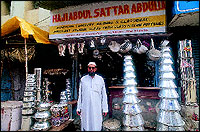 But enterprising chefs in the city�s big hotels do produce a thali for lunch that has the best of both worlds. Outside of the hotels, is where there is real Aurangabadi soul food. Like the Islami Hotel near Delhi Gate which serves a wicked plate of Paya with Roti early in the morning for breakfast. It is said to be a speciality of Aurangabad and you better go prepared to be shocked by the surroundings in which you are going to be starting your gastronomy journey in the city. It is extremely downmarket!
But enterprising chefs in the city�s big hotels do produce a thali for lunch that has the best of both worlds. Outside of the hotels, is where there is real Aurangabadi soul food. Like the Islami Hotel near Delhi Gate which serves a wicked plate of Paya with Roti early in the morning for breakfast. It is said to be a speciality of Aurangabad and you better go prepared to be shocked by the surroundings in which you are going to be starting your gastronomy journey in the city. It is extremely downmarket!
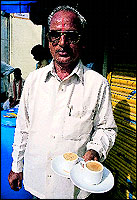 Getting on and getting deep into the city, you will find the 25-year-old Samadhan Tea House at Paithan Gate near the Gulmandir. It is Aurangabad�s oldest tea house which is not saying much. But its proprietor, Keshavrao Amrutrao Bhunge, is unconcerned about dates. Ask him about his special Golden Tea, a thickish brew that is made of three different tea leaves and which is slightly orange in colour, and he will open up.
Getting on and getting deep into the city, you will find the 25-year-old Samadhan Tea House at Paithan Gate near the Gulmandir. It is Aurangabad�s oldest tea house which is not saying much. But its proprietor, Keshavrao Amrutrao Bhunge, is unconcerned about dates. Ask him about his special Golden Tea, a thickish brew that is made of three different tea leaves and which is slightly orange in colour, and he will open up.
A cup of this costs Rs. 4 and from 6 a.m. till 11 p.m., he makes and sells only this amazing cup of Golden Tea. People used to come till 2 a.m. also but then the police frowned on this practise of his to keep such odd business hours. Still, Keshavrao manages to serve at least 4,000 cups of tea a day! He is famous in all of Aurangabad.
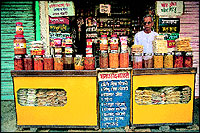 But not so famous as the Uttam Sweet Home where for 70 years, the Imartis and Jelebis made here have been feeding people�s sweet-tooths and giving doctors nightmares about a city full of diabetics!
But not so famous as the Uttam Sweet Home where for 70 years, the Imartis and Jelebis made here have been feeding people�s sweet-tooths and giving doctors nightmares about a city full of diabetics!
The Aurangabadis love bhajiyas as well and Uttam Sweet Home keeps dishing out jelebis and bhajiyas till 10 p.m. The evenings are ruled by the chaat and bhelpuriwallahs. King among them is Balkrishna Ganpatrao Tiwari whose Gayatri Chaat Bhandar is 35 years old and where the Mung Bhajiya and Kachori are to die for. He is open only from 5 to 10 p.m. but during that time, the road outside is a jam-packed with the traffic of people coming to eat his special savouries.
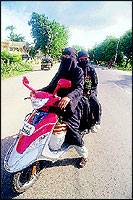 Another great character of the Aurangabad fast food scene is Shivlingappa Rao Mane who runs the Bholeshankar Bhelpuri shop with a professional efficiency that is a delight to watch. He is known as �Bhelwala Appa� and his speciality is the �Bombay Bhel� that he mixes personally by hand. Bhelwalla Appa used to function off a cart some 24 years ago, now he has a regular shop that he keeps open from 6 to 11 p.m. In that time, all of Aurangabad comes here to eat bhelpuri, he says with quiet satisfaction. There are other places that run late into the night like Sagar restaurant, the Mughlai eating house that serves a Chicken Kentucky (spelt �Cantukky�, hilariously!) you would have to be brave to try out, and which specialises in the Naan-Kalia, a dish not on the menu, but whose taste every Aurangabad Muslim swears by.
Another great character of the Aurangabad fast food scene is Shivlingappa Rao Mane who runs the Bholeshankar Bhelpuri shop with a professional efficiency that is a delight to watch. He is known as �Bhelwala Appa� and his speciality is the �Bombay Bhel� that he mixes personally by hand. Bhelwalla Appa used to function off a cart some 24 years ago, now he has a regular shop that he keeps open from 6 to 11 p.m. In that time, all of Aurangabad comes here to eat bhelpuri, he says with quiet satisfaction. There are other places that run late into the night like Sagar restaurant, the Mughlai eating house that serves a Chicken Kentucky (spelt �Cantukky�, hilariously!) you would have to be brave to try out, and which specialises in the Naan-Kalia, a dish not on the menu, but whose taste every Aurangabad Muslim swears by.
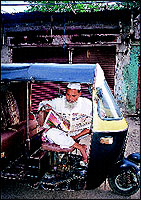 There are other places of interest for the foodie like the Aurangapura Market to which women ride up on bikes every morning and where the produce includes the freshest greens from the villages around Aurangabad plus luscious fruits and shops selling masala powders, pickles, murabas and spices.
There are other places of interest for the foodie like the Aurangapura Market to which women ride up on bikes every morning and where the produce includes the freshest greens from the villages around Aurangabad plus luscious fruits and shops selling masala powders, pickles, murabas and spices.
And there are the purfumers of Aurangabad, Haji Mir Maqsood Ali & Son being one of them, his family being in the business for 150 years and the fifth generation being represented by Mir Azhar Ali. The perfumers are in Attar Galli, City Chowk, they are all open from 7.30 in the morning to 9.30 at night. All kinds of people come for attars, says Mir Azhar Ali, especially the Gulab, Hina and Shamana attars which cost as much as Rs. 140 for 10 grams. Fortunately, good things also come in small packages. And he offers attars in tiny 1.5 gm bottles as well. Work out how much that costs, then!





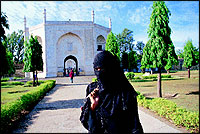 Mughlai Maratha Melange!
Mughlai Maratha Melange!
 Aurangabad is Maharashtra�s most important tourist destination, it is fringed by the Satmala Hills and the Kaum River, and is not too far from Bombay by road � just 390 kilometres or an eight-hour drive. The train takes lesser time than that. But air is the quickest: the flight from Bombay is just 45 minutes.
Aurangabad is Maharashtra�s most important tourist destination, it is fringed by the Satmala Hills and the Kaum River, and is not too far from Bombay by road � just 390 kilometres or an eight-hour drive. The train takes lesser time than that. But air is the quickest: the flight from Bombay is just 45 minutes. Aurangabad, of course, gets its name from the man who brought the mighty Mughal dynasty of Zahiruddin Babbar to an end over here. Mohammed Aurangzeb, Babar�s sixth descendant, lies buried in Khuldabad just 24 kilometres outside Aurangabad. He was the most able commander and son of his father, Emperor Shah Jehan, but he was also the most wronged son according to travelogues on the city.
Aurangabad, of course, gets its name from the man who brought the mighty Mughal dynasty of Zahiruddin Babbar to an end over here. Mohammed Aurangzeb, Babar�s sixth descendant, lies buried in Khuldabad just 24 kilometres outside Aurangabad. He was the most able commander and son of his father, Emperor Shah Jehan, but he was also the most wronged son according to travelogues on the city.  His tomb there today which lies in verdant and quiet surroundings, is a place of tourist interest. And curiously enough, one of the big sweetmeat delicacies of Aurangabad, the Khaja, is sold in little tents right outside the tomb. Nobody who visits the place comes away without sampling the sweet.
His tomb there today which lies in verdant and quiet surroundings, is a place of tourist interest. And curiously enough, one of the big sweetmeat delicacies of Aurangabad, the Khaja, is sold in little tents right outside the tomb. Nobody who visits the place comes away without sampling the sweet. Aurangabad has a sizeable population of members belonging to the Dawoodi Bohra community as well and these people are traders, they deal in perfumes, Unani medicines, hardware, and have other establishments. Another area of great Muslim influence in Aurangabad is education. The city is a wonderful and renowned seat of learning thanks to the Maulana Azad Educational Trust started by Dr. Rafiq Zakaria and its colleges of arts, science, commerce, its polytechnic, technological institute, colleges of pharmacy, journalism, computers, information technology, management and hotel management. Students come from far and wide to seek admissions in these institutes and they come bringing their own cultures with them, adding to the melange that already exists in Aurangabad.
Aurangabad has a sizeable population of members belonging to the Dawoodi Bohra community as well and these people are traders, they deal in perfumes, Unani medicines, hardware, and have other establishments. Another area of great Muslim influence in Aurangabad is education. The city is a wonderful and renowned seat of learning thanks to the Maulana Azad Educational Trust started by Dr. Rafiq Zakaria and its colleges of arts, science, commerce, its polytechnic, technological institute, colleges of pharmacy, journalism, computers, information technology, management and hotel management. Students come from far and wide to seek admissions in these institutes and they come bringing their own cultures with them, adding to the melange that already exists in Aurangabad. The roads that go out of Aurangabad are the ones that archaeologists and students of history take. They lead to some of India�s most important sites of heritage and natural wealth. The western road to Bombay goes past Ellora�s Buddhist caves; the southern road to Paithan, on the banks of the Godavari; the northern road to Jalgaon and along which are a number of sights leading upto Ajanta; and, the Jalna road is on the east.
The roads that go out of Aurangabad are the ones that archaeologists and students of history take. They lead to some of India�s most important sites of heritage and natural wealth. The western road to Bombay goes past Ellora�s Buddhist caves; the southern road to Paithan, on the banks of the Godavari; the northern road to Jalgaon and along which are a number of sights leading upto Ajanta; and, the Jalna road is on the east.  But within the city itself, are the Bibi-ka-Maqbara, a tribute not unlike the Taj Mahal in Agra but this one to Aurangzeb�s wife Begum Rabia Durani by her son Azam Shah. And there is the Panchakki, a water wheel that works in the day and age and which draws water from a reservoir six kilometres away through an elaborate assemblage of ceramic pipes and and an iron fan that also churns electricity for a flour mill to grind grain for pilgrims.
But within the city itself, are the Bibi-ka-Maqbara, a tribute not unlike the Taj Mahal in Agra but this one to Aurangzeb�s wife Begum Rabia Durani by her son Azam Shah. And there is the Panchakki, a water wheel that works in the day and age and which draws water from a reservoir six kilometres away through an elaborate assemblage of ceramic pipes and and an iron fan that also churns electricity for a flour mill to grind grain for pilgrims.  The city still has some of its old darwazas like the Delhi, Paithan, Jalna and Mecca darwazas that have withstood the elements like they did the attacks of the Marathas, but these are withering with age and almost reduced to rubble in some places. Then there are a number of masjids and dargahs scattered around the city, with the Jama Masjid standing over them all.
The city still has some of its old darwazas like the Delhi, Paithan, Jalna and Mecca darwazas that have withstood the elements like they did the attacks of the Marathas, but these are withering with age and almost reduced to rubble in some places. Then there are a number of masjids and dargahs scattered around the city, with the Jama Masjid standing over them all. But enterprising chefs in the city�s big hotels do produce a thali for lunch that has the best of both worlds. Outside of the hotels, is where there is real Aurangabadi soul food. Like the Islami Hotel near Delhi Gate which serves a wicked plate of Paya with Roti early in the morning for breakfast. It is said to be a speciality of Aurangabad and you better go prepared to be shocked by the surroundings in which you are going to be starting your gastronomy journey in the city. It is extremely downmarket!
But enterprising chefs in the city�s big hotels do produce a thali for lunch that has the best of both worlds. Outside of the hotels, is where there is real Aurangabadi soul food. Like the Islami Hotel near Delhi Gate which serves a wicked plate of Paya with Roti early in the morning for breakfast. It is said to be a speciality of Aurangabad and you better go prepared to be shocked by the surroundings in which you are going to be starting your gastronomy journey in the city. It is extremely downmarket! Getting on and getting deep into the city, you will find the 25-year-old Samadhan Tea House at Paithan Gate near the Gulmandir. It is Aurangabad�s oldest tea house which is not saying much. But its proprietor, Keshavrao Amrutrao Bhunge, is unconcerned about dates. Ask him about his special Golden Tea, a thickish brew that is made of three different tea leaves and which is slightly orange in colour, and he will open up.
Getting on and getting deep into the city, you will find the 25-year-old Samadhan Tea House at Paithan Gate near the Gulmandir. It is Aurangabad�s oldest tea house which is not saying much. But its proprietor, Keshavrao Amrutrao Bhunge, is unconcerned about dates. Ask him about his special Golden Tea, a thickish brew that is made of three different tea leaves and which is slightly orange in colour, and he will open up.  But not so famous as the Uttam Sweet Home where for 70 years, the Imartis and Jelebis made here have been feeding people�s sweet-tooths and giving doctors nightmares about a city full of diabetics!
But not so famous as the Uttam Sweet Home where for 70 years, the Imartis and Jelebis made here have been feeding people�s sweet-tooths and giving doctors nightmares about a city full of diabetics!  Another great character of the Aurangabad fast food scene is Shivlingappa Rao Mane who runs the Bholeshankar Bhelpuri shop with a professional efficiency that is a delight to watch. He is known as �Bhelwala Appa� and his speciality is the �Bombay Bhel� that he mixes personally by hand. Bhelwalla Appa used to function off a cart some 24 years ago, now he has a regular shop that he keeps open from 6 to 11 p.m. In that time, all of Aurangabad comes here to eat bhelpuri, he says with quiet satisfaction. There are other places that run late into the night like Sagar restaurant, the Mughlai eating house that serves a Chicken Kentucky (spelt �Cantukky�, hilariously!) you would have to be brave to try out, and which specialises in the Naan-Kalia, a dish not on the menu, but whose taste every Aurangabad Muslim swears by.
Another great character of the Aurangabad fast food scene is Shivlingappa Rao Mane who runs the Bholeshankar Bhelpuri shop with a professional efficiency that is a delight to watch. He is known as �Bhelwala Appa� and his speciality is the �Bombay Bhel� that he mixes personally by hand. Bhelwalla Appa used to function off a cart some 24 years ago, now he has a regular shop that he keeps open from 6 to 11 p.m. In that time, all of Aurangabad comes here to eat bhelpuri, he says with quiet satisfaction. There are other places that run late into the night like Sagar restaurant, the Mughlai eating house that serves a Chicken Kentucky (spelt �Cantukky�, hilariously!) you would have to be brave to try out, and which specialises in the Naan-Kalia, a dish not on the menu, but whose taste every Aurangabad Muslim swears by. There are other places of interest for the foodie like the Aurangapura Market to which women ride up on bikes every morning and where the produce includes the freshest greens from the villages around Aurangabad plus luscious fruits and shops selling masala powders, pickles, murabas and spices.
There are other places of interest for the foodie like the Aurangapura Market to which women ride up on bikes every morning and where the produce includes the freshest greens from the villages around Aurangabad plus luscious fruits and shops selling masala powders, pickles, murabas and spices.